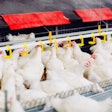
From feeding to meat quality defects to labor challenges, new innovations are poised to improve efficiency and productivity throughout the poultry industry.
During the panel discussion, “Implementation of Precision Poultry Technologies,” at the 2024 Georgia Precision Poultry Farming Conference, three industry experts shared their experience with three emerging poultry technologies.
The panelists were:
- Seung-Chul Yoon, research electronics engineer, Quality and Safety Assessment Research Unit, U.S. National Poultry Research Center
- Martin J. Zuidhof, professor, Facility of Agricultural, Life and Environmental Science, University of Alberta
- Konrad Ahlin, senior research engineer, Georgia Tech Research Institute
1. Hyperspectral imaging
Hyperspectral imaging can detect meat safety contaminants, quality defects like woody breast and quality variations during poultry processing. It’s more sensitive than what has previously been used, however this emerging optical imaging technology has not yet been widely adopted by the industry yet due to its complexity, cost and big data requirements, Yoon said.
“It goes beyond what the human eye can see,” he added.
The technology uses optical imaging and deep learning Artificial Intelligence (AI) systems to identify myopathies, such as woody breast, using cameras that look for meat defects.
2. Precision feeding
Precision feeding is one example of precision farming, which uses sensor data to implement optimal decisions in real-time.
“Smart nutrition will increasingly be used to optimize feeding decisions going forward,” Zuidhof predicted. “The whole concept was driven initially by a lack of uniformity when feeding broiler breeders.”
The goal of precision feeding is to make data-driven decisions to match nutrient supply to the nutrient requirements of poultry. During precision feeding, birds wearing RFID tags enter a feeding station, which measures its body weight. Poultry that weigh less than the target body weight are given access to the feed, while the door to the feed remains closed for birds above the body weight target.
This type of setup also allows operators to give particular bird’s access to specialized diets.
Initially studies have revealed that broiler breeders fed via precision feeding stations have shown productivity gains in fertility and egg production, as well as feed conversion.
3. Robotics in poultry processing
Robotics and automation have long been promised as a solution to labor shortages in the poultry industry, but they are not yet advanced enough. To succeed in poultry environments, robotic systems need to work in a shared workspace, work on a shared task and work cooperatively, Ahlin explained.
Ahlin’s lab is working on high dimensional robots that work collaboratively with each other to lift and move poultry carcasses. He’s also part of a project that harnesses virtual reality to create a human-robot interface for poultry processing environments.

















